The Jewish Ghetto in Rome is one of the city’s most interesting areas. It would be more accurate to call the small neighborhood the Quartiere Ebraico (Hebrew Quarter) because the light-filled streets near the Tiber River are certainly no longer a ghetto. But this where Rome’s Jewish population was forced to live for hundreds of years.
I often go out of my way to walk through Rome’s Jewish Ghetto when I am on my way to the center. When I pass by, I usually stop to look at the stumbling stones – memorials to the Jews who were arrested on October 16, 1943, during the Nazi occupation of Rome.
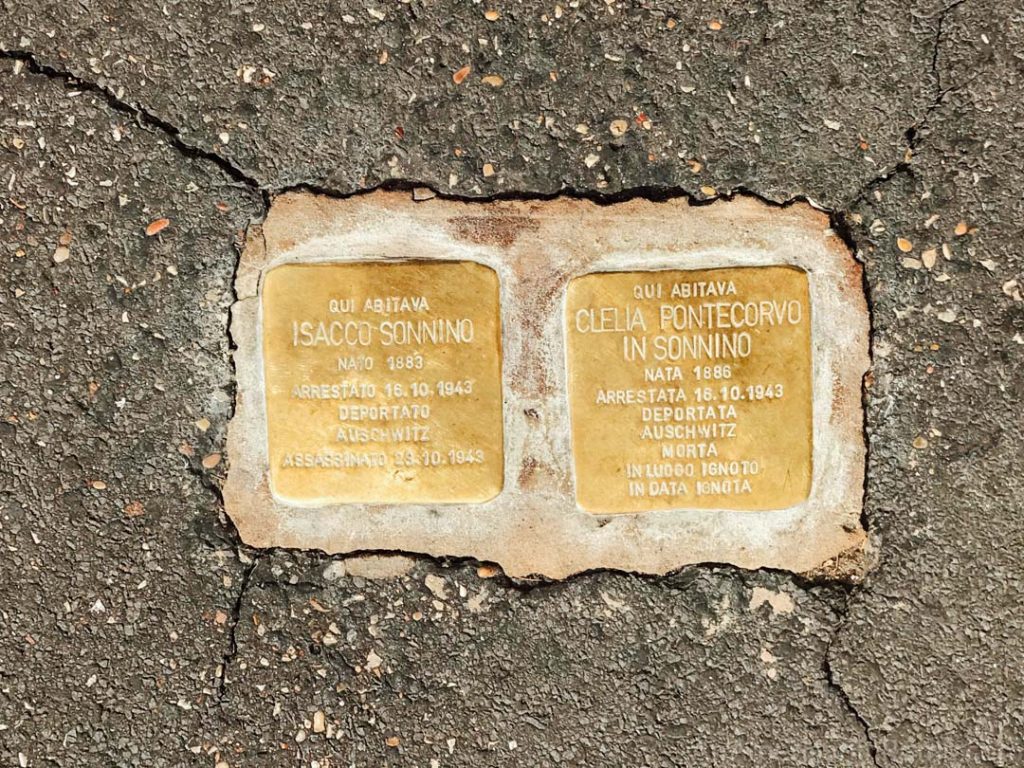
However, aside from a pretty surface-level knowledge of the history of the ghetto, I found it hard to imagine what life would have really been like here during those centuries when the gates were closed and rules were in place to make a population’s mere existence as difficult as possible.
That is why I absolute jumped at the chance to take a Jewish Roma tour from Micaela. Micaela was born in Rome and has been a part of the Jewish community in Rome her entire life. She knows the history of the Jewish Ghetto in Rome better than pretty much anyone else (save for MAYBE the director of the museum… maybe), plus she is vivacious and funny and really connects with everyone on her tour.

A tour of Jewish Rome starts at the Jewish History Museum of Rome, which recounts the 22-centuries of Jewish history in Rome. The first Jews arrived in Rome during Chanukah in 160 B.C. and there has been a Jewish population in Rome ever since – making this the most ancient Jewish population in Europe.
Eventually, the Roman Empire fell and Christianity took hold (remember – the Vatican is just across the river). However, the Roman Jewish Ghetto was only established in 1555 by a Papal bull which declared that all Jews in Rome must live in tiny, and flood-prone, area. What is more, it established rules to be followed, including:
- all Jews must live entirely in one designated area, completely separate from Christians;
- there could be only one Synagogue (but the Roman Jews eventually got around this rule by creating five subdivided synagogues under a single roof);
- whenever they left the Rome Ghetto, they had to be recognizable everywhere. Men were required to wear a large, cone hat with bells. Women had to the same sign that identified prostitutes);
- they could not fraternize with Christians or have any Christain servants. No Jews could be superior to Christians in any way;
- the only work they were permitted to do was rag-trading – they could not sell anything else;
- No working or having work done on Sundays;
- Jews living in the Rome Ghetto were required to attend church services on Sunday. However, many stuffed their ears with wax or cotton so that they would not hear a word of the mass they were forced to attend.
The Pope’s goal in creating the Jewish Ghetto in Rome was to make life difficult and to eventually convert the Jewish population of Rome. The reasoning being – if Jews converted to Christianity, their souls (in the eyes of the Vatican) would be saved and they could leave the Ghetto and live among their Christian brothers).
Life was indeed difficult. The Ghetto was tiny (see the map below). As the population grew, more people were forced to live in the same tiny space. The houses grew higher and higher, adding more (often unsafe) stories in which to house the expanding families.

Finally, the ghetto walls were torn down in the 1870s – after Italy became a united country and Rome was
Map of the Old Jewish Ghetto in Rome

The Jewish Ghetto in Rome sits just below Campo de’ Fiori, bordered by the Tiber River and Teatro Marcello. This was before the river had any embankments, so the tiny neighborhood would regularly flood. The ghetto was limited to an area of three streets, walled in and gated. Exits were tightly controlled and there was curfew for inhabitants.
Rome Synagogue
What I really appreciated on the tour I took of the Roman Ghetto was the chance to step inside Tempio Maggiore – the Great Synagogue. I have long been an admirer of the Synagogue because it is a distinctive part of the Rome skyline.

Surrounded by rounded church domes, the Great Synagogue of Rome in instantly recognizable.
The synagogue only opened in 1904, after the Jewish Ghetto was no longer a ghetto – but the area was still where many of Rome’s Jewish families lived.

Naturally, it is even more impressive from inside and the interior of that distinctive dome is a covered in a rainbow of colors.
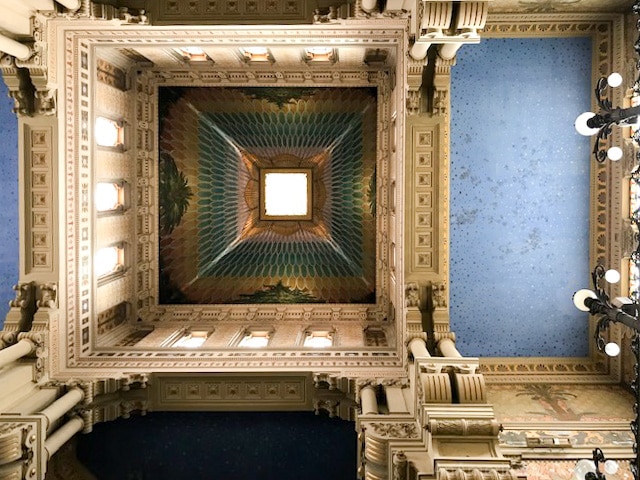
As we sat in the synagogue, Micaela shared more about her experience growing up Jewish in Rome, as well as recounted the history of the building. We learned about the attack that took place here.
Leaving the Tempio Maggiore, we walked through the streets of the ghetto, stopped at the border of the neighborhood to admire the Turtle Fountain, and then rounded back to Boccione for a piece of pizza ebraica.
The Jewish Ghetto in Rome Today
The Jewish Ghetto is one of Rome’s most unique neighborhoods and is also one of its most historic, though that history comes with a heavy dose of tragedy.
However, after the walls of the ghetto were torn down, most of the neighborhood was demolished. The buildings were in a poor condition and the living coniditions were very undersirable. That means that the light-filled neighborhood that you see today is not what Rome’s Jewish Ghetto would have looked like when the area was a true ghetto. Most of the buildings date back to the late 19th century.
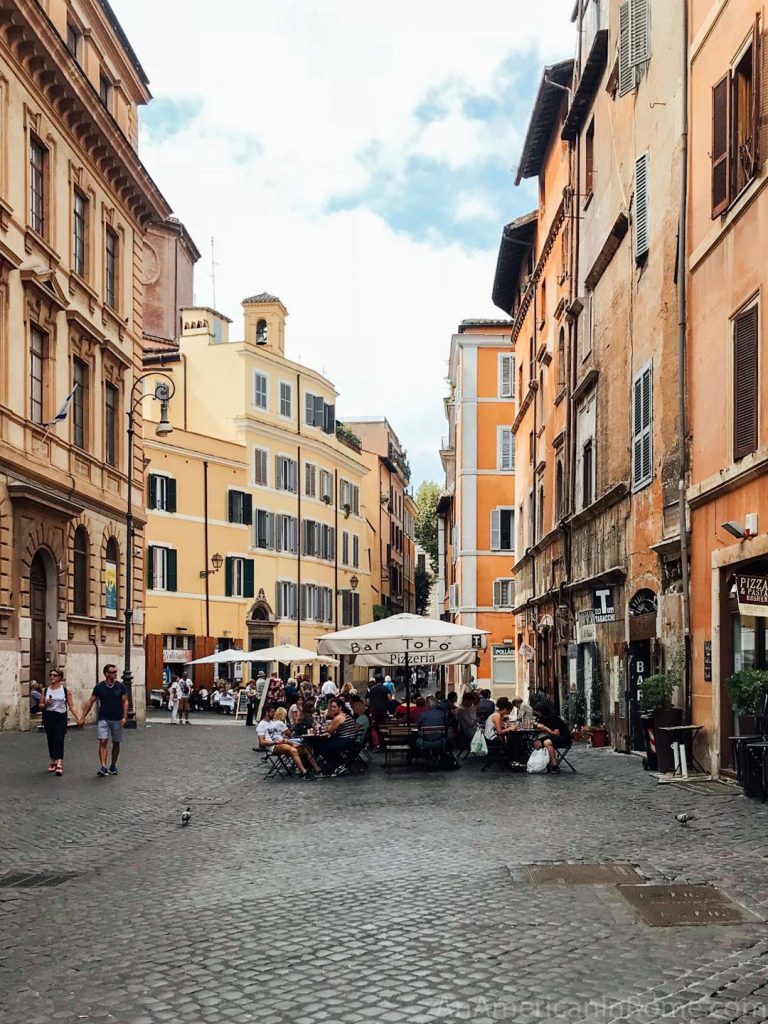
The main street in the Jewish Ghetto is Via del Portico d’Ottavia and it is fully pedestrianized (except for a few hours of the day when deliveries are allowed). The area is well known for its restaurants, and many specialized in Rome Jewish cuisine like fried artichokes, which are known as carciofi alla giudia.
While many Jewish families have moved to other parts of the city, the neighborhood is still where you will find the city’s Jewish school, as well as the Great Synagogue. There is also a Jewish bookstore with English, Italian and Hebrew language books at Via del Tempio, 2.
Want to explore more of the city? Here is a Rome neighborhoods guide to get you started.
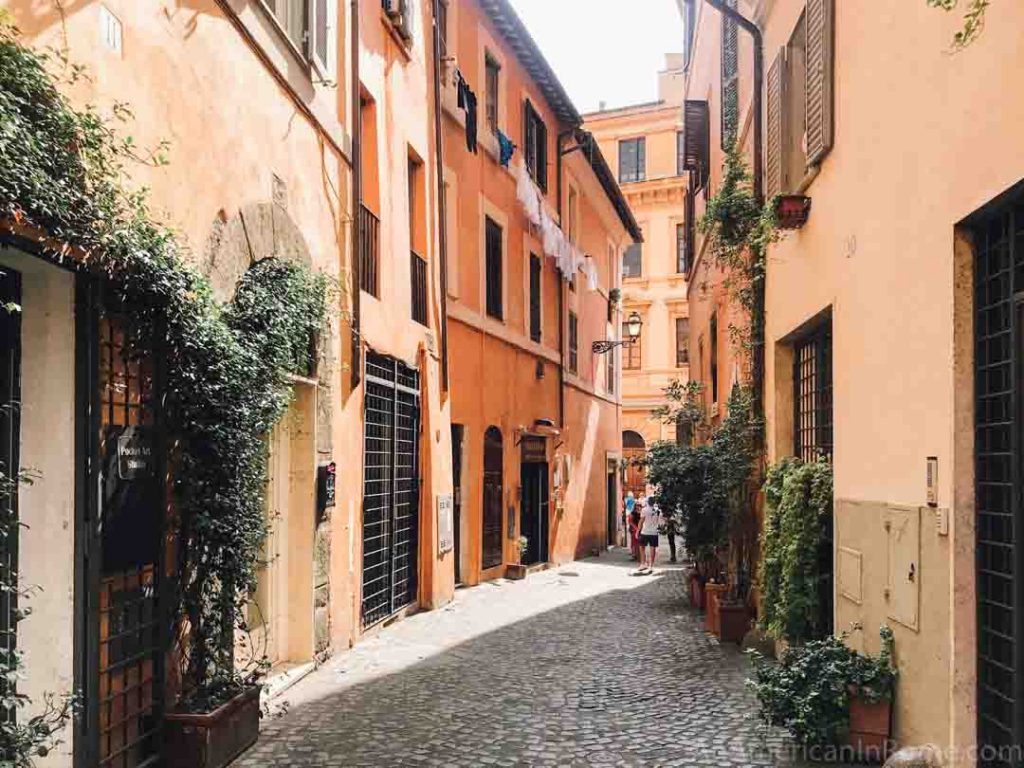
Note: Micaela invited me to join her tour, and I honestly cannot recommend the experience enough. It is something I should have booked for myself years ago. I learned so much and truly enjoyed her knowledge of history and the personal touches that she shares with the groups on the Jewish Roma tours.




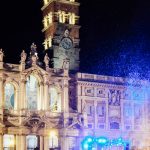
Why can’t I find you in the WordPress search? I want your new blogs to pop up every time I log on.
The neighborhood is absolutely gorgeous as the sun is setting. Perfect place for dinner.
HI, Natalie,
I really like your blog which shares so much info about Rome, we are planning a trip to Rome next week, and will def do something you recommend. Appreciate your good work, please keep it up!
Hi Gabbie! Thanks so much for your kind words of encouragement! I hope you have a wonderful time in Rome!
Are most shops open in Jewish Ghetto on Liberation Day?
Hi Natalie,
This is Asher Bentolila. I do the same than Michaela but in Toledo and Segovia, and will be happy to welcome you here in Spain and tell about those cities. http://Www.jewishsegovia.com
Cheers!
Asher
Great to know! Thanks, Asher!
Is the Jewish Ghetto open on Christmas?
It is still a national holiday in Italy, so it depends on the business. The area itself can always be explored, any day of the year.
Going to Rome in September and would like to stay close to the Jewish ghetto. Any suggestions.
Hi, Could you please grant me the copyright to use the above picture?
Thank you!
No, apologies. I retain copyright to all photos.